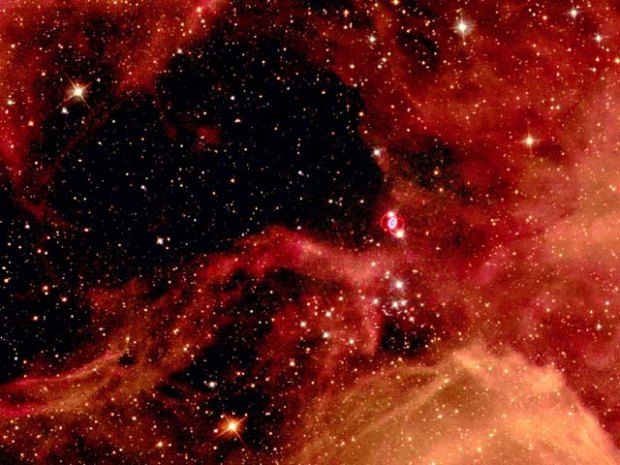Supernovas are the result of massive emissions of cosmic rays which have the capacity of radiating the same amount of energy that the sun would emit in its life span. Just as people do, stars have a finite life. Born in dusty gas clouds of a galaxy’s spiral arms, stars fuse hydrogen into heavier elements during their energy-producing lifetimes.
For stars, mass translates into destiny. The smallest can glow like embers for trillions of years. A middleweight star like our Sun burns steadily for 10 billion years; eventually, it puffs off its outer layers as expanding gaseous shells known as a planetary nebula.
The most massive stars — furiously hot, blue-white orbs — shine brightly for a few million years and end their lives in spectacular explosions. Supernova explosions are rare but incredible. In a mere second, a supernova unleashes as much energy as the sum of all other stars in the observable universe. For weeks, the shattered star may rival the light output of its entire host galaxy. The brightest recent supernova occurred in 1987 in the Large Magellanic Cloud, a satellite galaxy of the Milky Way 168,000 light-years away.

The explosion, known as Supernova 1987A, left behind a remnant that’s changing as astronomers watch. A shock wave traveling at 10 million mph (16 million km/h) is plowing into a ring of gas ejected before the star died. This heats knots of gas in the ring to more than 18 mil- lion degrees F (10 million degrees C) — so hot the knots emit X-rays. Stars fuse hydrogen and helium into heavier elements such as oxygen, carbon, and iron, but the remaining elements are forged in the heart of supernova explosions.
Atoms in our bodies, including the iron in our blood and the calcium in our teeth, were scattered into space during the deaths of massive stars.
The blasts cast these heavy elements into the universe, enriching the galaxy for the next stellar generation. Atoms in our bodies, including the iron in our blood and the calcium in our teeth, were scattered into space during the deaths of massive stars. As Carl Sagan was fond of saying, we are made of star stuff. Supernovae are not created equal, however. In cataloging these beasts, astronomers have found significant spectral differences.
Recommended: Supernova and its Effect on Earth
The current classification scheme, devised in 1941 by American astronomer Rudolph Minkowski of California’s Mt. Wilson Observatory, focuses on hydrogen, which is easy to trace. A type I supernova is one that shows no broad absorption lines or emission lines corresponding to hydrogen. If the super- nova shows hydrogen either in absorption or emission, astronomers class the exploding star as type II. Type I supernovae are remarkably consistent; it’s easy to recognize them throughout the universe. Later, some peculiarities arose.
Astronomers found some type I supernovae lacking silicon, and they occasionally found others that showed the presence of helium. Scientists dubbed these rare, strange creatures types Ib and Ic supernovae and reclassified all others as type Ia. By the 1990s, astronomers had amassed a wide enough set of observations to say with some confidence what kinds of stars are exploding. Type Ia supernovae occur in binary systems that contain two stars of different masses that started life in close proximity.
As the white dwarf approaches a critical mass, its carbon heart detonates, completely destroying the star.
The binary’s heavier star fuses hydrogen into helium rapidly, and, once it exhausts hydrogen, it swells into a red giant and begins fusing heavier elements in its core. Ejecting its outer layers, the massive star now is a white dwarf. The star’s neighbor accretes some of the shed gas. The companion’s mass grows, which dramatically increases its internal temperature and the rate at which the star consumes its fuel.
The second star swells to become a red giant. It swells so much, in fact, that its outer atmosphere extends much of the way to the white dwarf. Some of this gas now falls onto the dwarf. If the rate at which gas falls onto the dwarf is slow enough, the material accumulates on the dwarf rather than fusing. The white dwarf slowly gains mass. As the white dwarf approaches a critical mass, its carbon heart detonates, completely destroying the star. As a result of the explosion, the dwarf’s red-giant companion races off into space.
Without supernovae, the heaviest elements forged inside stars would never be scattered into space.
Supernova 1987A was a type II supernova. It began life as a star more than 8 times the Sun’s mass, which glows blue-white. As the star exhausts its hydrogen fuel, it fuses ever heavier elements, ultimately leaving an iron core surrounded by silicon, oxygen, carbon, and helium shells. But iron fusion requires more energy than it gives, and the star’s iron core collapses. At densities exceeding that of an atomic nucleus, the inner core stiffens, rebounds, and expands outward against the still-collapsing star. This makes a violent shock that shatters the star, but the details still elude astronomers.
Without supernovae, the heaviest elements forged inside stars would never be scattered into space. Type Ia supernovae show such little variation in their energy outputs that they’ve become important tools for exploring the distant cosmos.
Study of these explosions reveals the universe’s expansion is accelerating.
Study of these explosions reveals the universe’s expansion is accelerating. With regards to planet Earth, some isotope signatures were discovered in the deep sea rocks of the Pacific Ocean and in 2009, nitrate ions were found in the Antarctic Ice. Lately, there has also been the interesting discovery of Supernova dust being detected in Antarctic meteorites.
-end-


































